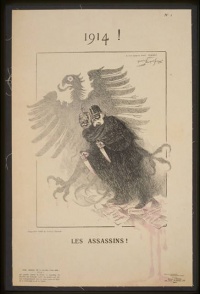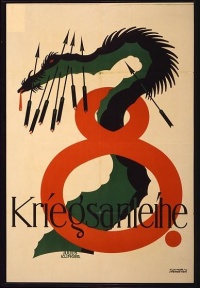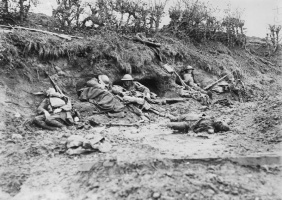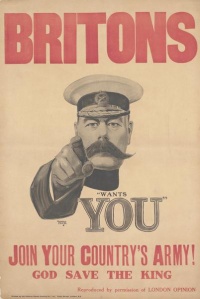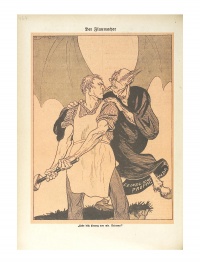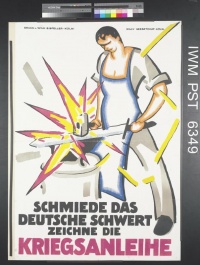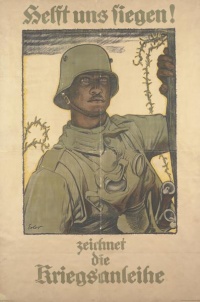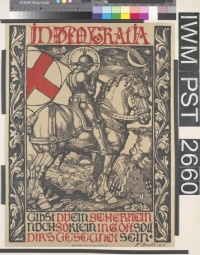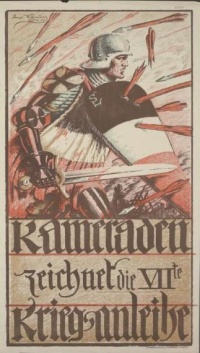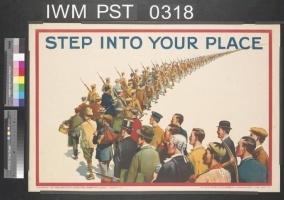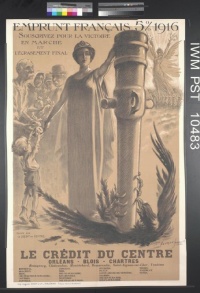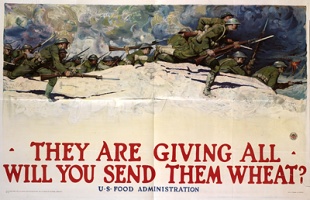Introduction↑
Although there were some precedents for war propaganda involving the media dating back to the early 19th century (and war propaganda itself is as old as history), the First World War was the first war in which belligerent governments deliberately created organisations to generate and direct propaganda at their enemies, at their allies, at neutrals, and at their own populations, as an essential part of the way that they waged war. The First World War came at a time when a variety of interacting political, social, commercial, military and technological factors had produced a very wide range of media through which propaganda could be disseminated, including both official and unofficial channels, newspapers, speeches, films, photographs, posters, books, pamphlets, periodicals, and cartoons. The same interaction also provided the opportunity for wartime official mechanisms that restricted information and knowledge by controlling the media through censorship, while few alternative sources of information were generally available. In all countries, the relationship between propaganda institutions and the mass media was of great importance. But it must also be stressed that much propaganda generated in all countries was the product of non-government initiatives, or of government co-operation with private institutions, and that much of this propaganda was on a small and local scale. Historical study has tended to focus on large events and exceptional episodes, simply because they are more historically visible.
Propaganda and the role of the media in the wider national and international politics of the First World War is itself still a contentious and contested subject. The existing historical literature of propaganda and the media in the war is large, but also highly variable in quality. Books and articles are still published that repeat positions and attitudes that have long since been discredited, or that use highly selective interpretations of propaganda in the war for polemical purposes related to modern political positions. While there are good general histories of propaganda through the ages, most historians of the First World War tend to ignore these, and rather than engaging with the various theories of propaganda, they assume a special importance for propaganda in this particular war. Recent general histories of the war, or of individual events and battles, are likely to refer to propaganda and to the media record, but the history of the propaganda of the war is still often approached as an isolated subject, rather than as intimately linked to its wider domestic and international politics and to warfighting. Historians of the news media in the war, meaning essentially in this period the newspapers (augmented to some extent by cinema newsreels), tend to approach the topic as an issue of free speech largely divorced from any wartime political or strategic context, and from the attitudes of the time, often assuming universal media rights. Cultural historians have placed heavy emphasis on the study of posters, paintings and similar easily accessible cultural artefacts, while cinema and other media, which had much greater influence at the time, have been comparatively neglected. The importance of propaganda events that have left little record, such as the thousands of extemporary speeches given in all countries, has also been neglected. Finally, studies of the war’s propaganda have mostly considered only mass media and mass effects. Very little attention has been paid to propaganda aimed at influencing elites, despite the importance of such propaganda during the war.
In the case of individual countries, there is a large variation in the amount of attention devoted by historians to the study of the propaganda organisations, policies and methods, and almost no comparative studies between countries. One consequence of this is that accounts dealing with individual countries often share the perspective of that country’s government during the war, including a belief of each country’s government that other countries enjoyed superior propaganda or managed their media relations better. Of the major belligerents, most is known about Great Britain and its Empire, and there have been studies of Germany, the United States, and France, but relatively little is known about the propaganda and media strategies of Italy, Austria-Hungary, Ottoman Turkey, and of Russia before the 1917 revolutions. This discrepancy in historical research accords with the wider issue that interest in propaganda has concentrated on countries in which mass politics and democracy were most developed by 1914.
For Great Britain, and to some extent for Germany and France, a major recent change in the approach to understanding First World War propaganda has been a growing interest in the way in which propaganda and the media interacted with larger issues of domestic attitudes and morale, in an approach that sees wartime propaganda studies as a branch of political and social history. For an era for which it is hard to measure mass public opinion, propaganda and the reaction to that propaganda both provide valuable evidence of how governments believed that mass societies would react, and how they actually did react. In contrast to this progress, little attention has been paid to the link between propaganda, military morale, the fighting fronts, and the conduct of battles. To mention just two examples, both the role of French propaganda in 1917 in concealing the extent of the French Army’s mutinies and its recovery, and the connection between Allied propaganda and their defeat of the German Army on the Western Front in 1918, are still very much neglected and contested issues. The outstanding exception to this present neglect is the extensive study of the wartime and post-war propaganda of the “Belgian atrocities” of 1914 in the context both of domestic and international politics and of the military conduct of the war.[1]
The purpose of this essay is to provide an overview of the major propaganda organisations, policies and ideas of the main belligerents of the war, with an emphasis on the British about who most is known. This begins with a summary of the various national propaganda organisations, starting with the Allies and the United States, followed by the Central Powers. This is followed by an identification of some of the key propagandists on all sides in the war, and their views of the nature of propaganda. The final section deals with the influence of the experience of the war on the development of the idea of propaganda as a weapon of war, and the relationship between First World War propaganda and modern theories of propaganda.
National Propaganda Organisations↑
Of the major Allied powers, on the outbreak of the war, Great Britain had no official propaganda organisations, although the British Foreign Office did have a News Department, and the chief British concern was with maintaining military secrecy and security in wartime. Some pre-planning had been done for censorship and control of the press, including the passing of a strengthened Official Secrets Act in 1911, and the existence of a sub-section of the Army’s General Staff in the War Office in London known as MO5(h), which on the war’s outbreak became responsible for the Army’s role in censorship and propaganda; the Royal Navy did not create a censorship office until after the war’s start. In August 1914 Great Britain passed the Defence of the Realm Act (D.O.R.A.), giving the government wide-ranging powers to prevent information judged harmful to the war effort being circulated or published. The War Office (Army) and Admiralty (Navy) also created a joint official Press Bureau as the main institution for press censorship and liaison on all issues.
British official censorship policy closely followed the country’s existing traditions in government and diplomacy: for the censor to pass something for publication did not mean that it was officially approved or acknowledged to be true, simply that it was not a threat to security. If a newspaper published an extreme claim about British or enemy actions, it was usually not government policy to comment. The British government’s relationship with the influential London press was largely based on mutual agreement, including an understanding that the very strong government powers under D.O.R.A. would only be applied in extreme cases in which it was felt that the press had breached what were essentially informal agreements and a mutual understanding. If a newspaper published or attempted to publish material without prior censorship then in rare cases the material might be seized, and individuals fined or imprisoned; dissident publications were closely monitored and sometimes blocked, but the suppression of major newspapers was unknown. The provincial press, the cinema newsreels, and other politically relatively unimportant sources of news received little government attention.[2]
Also on the outbreak of the war, the British created a secret organisation known from its London location as “Wellington House”, although later officially titled the War Propaganda Bureau, under Charles Masterman (1873-1927). Wellington House had a wide-ranging and general role in propaganda, which expanded in the course of the war. It began by working with the Foreign Office’s News Department, with its main propaganda output aimed at other countries, particularly at the neutrality of the United States before 1917, creating a British Information Bureau in New York. The Home Office (interior ministry) also created a Neutral Press Committee in 1914 to deal with all aspects of British propaganda in neutral countries. Wellington House was particularly active in supporting propaganda initiatives by private individuals, local and regional groups, and non-government institutions, working with government support. As a result, it is often hard to determine whether propaganda that appeared at the time to be non-governmental was in fact sponsored or supported by Wellington House or by other official British institutions, particularly in the case of books and pamphlets. Propaganda associated with recruiting volunteers for the British Army (before the introduction of conscription in early 1916), particularly recruiting posters, was overseen from 1914 onwards by the Parliamentary Recruiting Committee, headed by members of parliament.
There were several changes and additions to British propaganda organisations in 1916. The War Office’s MO5(h) propaganda department, which had expanded to become MO7 in 1915, was further expanded and renamed MI7, providing a large volume of written propaganda, including leaflets aimed at enemy troops on the fighting fronts to encourage surrender. The introduction of official war correspondents attached to the headquarters of the main fighting fronts, chiefly the Western Front, was overseen by MI7 and Wellington House through negotiation with the major British newspapers. Official still photographers and war artists were also introduced, both in Britain and on the main fighting fronts in 1916, also by cooperation between MI7 and Wellington House. After negotiations involving the cinema newsreel film industry, the War Office and Wellington House, official cine-cameramen were also established on the fighting fronts, producing their first films in 1916. Later in 1916 all official filming of the fighting fronts came under a newly-created War Office Cinema Committee, headed by the Canadian-born politician and newspaper proprietor Max Aitken, Lord Beaverbrook (1879-1964), created Lord Beaverbrook in 1917. This committee produced a series of major factual documentary films in 1916-1917, and from 1917 onwards a twice-weekly official newsreel. The British government already had a close relationship with the London-based Reuters news agency, and in 1916 a secret deal was made which, while preserving Reuters’ independence, prevented it from carrying anti-British propaganda or falling under enemy control.
In early 1917, Wellington House was absorbed into a new expanded propaganda organisation, the Department of Information, headed by the writer and later famous novelist John Buchan (1875-1940), created Lord Tweedsmuir in 1935). Although technically part of the Foreign Office, the Department of Information became responsible for both foreign and most domestic propaganda. In August 1917 it was augmented by the National War Aims Committee, a parliamentary organisation responsible chiefly for promoting domestic propaganda on a small-scale and regional basis. In early 1918, the Department of Information expanded again to become the completely independent Ministry of Information under Beaverbrook, absorbing the War Office Cinema Committee, and controlling or directing almost all British official propaganda organisations, except for the National War Aims Committee and MI7. In addition, in early 1918 the British created the Department of Propaganda in Enemy Countries, widely known as “Crewe House” from its London location, and headed by the newspaper proprietor Alfred Charles William Harmsworth, Lord Northcliffe (1865-1922), Alfred Harmsworth until he was ennobled in 1905.
This structure established in early 1918 of the Ministry of Information, the Department of Propaganda in Enemy Countries, the National War Aims Committee, the Official Press Bureau and MI7 for the War Office, continued until the end of the war, with a vast range of different means for propaganda at its disposal, including its influence on official war correspondents, control of official photographs and film, official paintings, leaflets, pamphlets, mail-shots, articles, and books. In the last months of the war the Central Powers were subject to a deluge of British propaganda, notably the German Army on the Western Front, as one aspect of the considerable superiority achieved by the Allies. But the British took the view that while this propaganda apparatus was important for winning the war, it had no place in a peacetime democracy. All these organisations were closed down rapidly in late 1918 and early 1919, before the conclusion of the Peace of Paris, leaving Great Britain without any official propaganda organisations. However, the British had decided in 1917 to create a permanent war memorial which became the Imperial War Museum in London in 1919, and many of their propaganda collections and records were transferred to this museum.
In propaganda, as in other aspects of the war effort, the link between Great Britain and its Empire, particularly the self-governing Dominions (Australia, Canada, New Zealand, and South Africa) and India was very close, with British propaganda organisations providing material for the whole Empire. But the Dominions and India also had their own extensive press, and after the war’s start both Canada and Australia created separate propaganda organisations connected to the main British organisations. This makes possible a comparative view of propaganda across the British Empire, and an investigation of the similarities and differences between British policies and those of the Dominions, and the responses of the Dominion press when compared to the British. In January 1915 the Canadian War Records Office was created in London, with the object of promoting and publicising (as well as recording) Canada’s contribution to the war. Also headed by Max Aitken (later Beaverbrook), this was responsible for propaganda including books, pamphlets, and the appointment of Canadian official still photographers and cine-cameramen on the Western Front. A similar Australian War Records Section was formed in London in May 1917 headed by the Australian official war correspondent Charles Bean (1879-1968). This provided Australian propaganda, including again photographers and cine-cameramen, and played an important part in developing the idea of a separate Australian identity as a result of the war. As their names suggest, these organisations were also intended to record Canadian and Australian wartime military achievements, and formed the basis of post-war official records, including in Australia’s case the Australian War Memorial in Canberra. The New Zealand forces on the Western Front had their own official photographer and cameraman, but otherwise the remaining Dominions and India did not have separate propaganda organisations.
France experienced a similar pattern and development in its propaganda organisations to Great Britain. Although to some extent the French modelled their propaganda organisations on those of the British, it is also true that all broadly democratic countries responded to the strains of the war in a similar fashion. The study of wartime propaganda for France has been largely concerned with the end-product, particularly issues of wartime censorship, and with the resistance of French intellectuals (and the assumed resistance of the mass of the population) to their own side’s domestic propaganda, later dismissed as bourrage de crâne (“brain-stuffing”). Despite the announcement of the domestic political truce or Union sacrée at the start of the war, successive French governments and the French Army were suspicious of the national press as being highly politicised and corrupt. Censorship was regulated by activating old 19th century laws governing security and conduct during a state of siege, updated in October 1913, and the Ministry of War created a Press Commission including newspaper representatives in August 1914 to oversee its operation. From the start of the war, France had overt censorship of its national and regional press of a kind that was almost unknown in Great Britain, with several newspapers being temporarily suspended for violation of press regulations, and stories appearing with sections blanked out by the censor. This was ostensibly done on military grounds, including attempts to replace all regional civilian censors with military personnel; but there were also arguments that successive governments were censoring or suppressing their political opponents. By the middle of 1917, after the shock of the French Army mutinies, the government and the press worked out a pragmatic approach similar to that of the British, with the press left to be largely self-regulating within accepted wartime rules. Most formal official propaganda was produced or directed by the Ministry of War as part of the wider French grand strategy. In October 1914 the Army created an Information Section to provide the press with regular communiqués from the front. In January 1916 the Maison de la Presse (press bureau) was established in Paris to coordinate official propaganda abroad. By early 1917, the Army had also allowed official war correspondents at the front, plus photographers and cine-cameramen who produced an official newsreel, exchanging material with the British. In March 1917, the broad-based Union des grandes associations contre le propaganda enemie or UGACPE (union of major associations to oppose enemy propaganda) was founded, based on networks of local patriotic organisations, which provided propaganda initiatives chiefly based on speeches, in a manner similar to the British National War Aims Committee.
Of the other main Allies, in Italy after its entry into the war in 1915 censorship and propaganda were seen as chiefly military responsibilities. The Italian Army played the major role in the wider Allied propaganda campaign directed at the continuing integrity of the Austro-Hungarian Empire, including by 1918 hosting the inter-Allied “Padua Commission” based at the Italian general headquarters. In Russia before 1917, most propaganda initiatives came from private institutions and individuals rather than the government, although the state-sponsored “Skobelev Commission” produced some domestic propaganda including films and postcards. The Belgian government in exile established after 1914 the Bureau Documentaire Belge (Belgian records office) at Le Havre in France.
The United States as an associated power created in April 1917, almost immediately on its entry into the war, the Committee on Public Information, commonly known as the “Creel Committee” from its chairman George Creel (1876-1953), a notionally independent government agency to oversee all aspects of propaganda and censorship. In a manner similar to that of Great Britain and France, the Espionage Act of June 1917 gave the United States’ government wide powers to restrict or control the press, extended even further by the Sedition Act of May 1918; but the Committee on Public Information preferred to come to informal agreements with the press rather than to use direct coercion or censorship. The Committee on Public Information’s main concern was domestic propaganda, and its approach was chiefly based on the emerging techniques of popular advertising. In structure it changed and expanded greatly in a few months, with as many as twenty different bureaux and departments, plus offices in thirty other countries. But broadly, by November 1918 it consisted of an Executive Division to oversee its work, and two main sections, a Domestic Section including a Division of News, and a Foreign Section. Its responsibilities and output included the full range of war propaganda media already deployed by the British and French. A particular innovation was the creation in September 1917 of the “Four Minute Men” (a name that recalled the “Minute Men” of the American Revolution), volunteers throughout the country who would give short inspirational speeches at public gatherings, intended to last no longer than four minutes; approximately the time needed to change the film reel on a projector at the cinema (a hiatus usually covered by music or other entertainment).
The approach of the Central Powers to wartime propaganda was in some ways significantly different to that of the Allies. Germany was the only belligerent country on either side which had considered the importance of propaganda to warfare before 1914, rather than simply being concerned with the threat of security leaks through the media and the need for wartime censorship. On the war’s outbreak a semi-official network already existed to disseminate a favourable view of Germany in other countries, and the German military had also considered deeply the matter of morale and support for a war among the German people. In contrast to the British relationship with Reuters, the German government openly subsidised its own semi-official news agency, the Wolff Telegraph Bureau, augmented after the war’s outbreak by the radio news service Überseedienst Transozean GmbH, which broadcast mostly German official propaganda. This use of official or officially acknowledged outlets for propaganda was typical of the German structure. For example, some major newspapers such as the Norddeutsche Allgemeine Zeitung and the Kölnische Zeitung were openly regarded as government mouthpieces.
A further contrast was that German propaganda was chiefly organised, and eventually dominated, by the military rather than by civilians. Along with similar agreements in other countries (including France’s Union sacré) Germany declared on the war’s outbreak a Burgfrieden (“fortress-truce”) between political opponents, accompanied by the activation of its own 19th century state of siege law, which effectively placed all Germany (except Bavaria which had different arrangements) under the control of Army district commanders. From August 1914 onwards, the German Army’s Oberste Heeresleitung or OHL (supreme command) made its Section III(b) or Nachrichtenabteilung (news section) responsible for censorship, public opinion and propaganda. Section III(b) gave frequent briefings to the German press, and issued directives on what it expected of them, creating within itself a special Press Service to ensure that these were carried out. In October 1914, Section III(b) also took administrative control of filming of the fighting fronts in October 1914, by co-opting Messter-Film GmbH and turning its Messter-Woche newsreel into an official propaganda vehicle. In February 1915, with support from the German press, the Oberzensurstelle (supreme censorship office) was established in Berlin, and in October 1915 it was expanded to become the Kriegspresseamt or K.P.A. (war press office) under Section III(b), divided into an Information Office and a Supreme Censorship Office. In October 1916 OHL created the new Militärische Film und Photostelle (military film and photography office) to control official still photographers and cine-cameramen. The role of Section III(b) grew in importance along with that of OHL itself in the course of the war, so that by 1917 under the OHL of First Quartermaster General Erich Ludendorff (1865-1937) it was the dominant German official propaganda organisation.
In addition to this military structure, in October 1914 the Foreign Office combined competing institutions within the diplomatic service with local organisations intended to promote Germany abroad, to form the Zentralstelle für Auslandsdienst (central office for foreign service). Often known as the “Erzberger Office” from its chairman Matthias Erzberger (1875-1921), the principal role of this office was to counter anti-German propaganda overseas, coordinating and often competing with Section III(b). In 1916, OHL created a new Militärische Stelle des Auswärtiges Amts or MAA (military office for foreign affairs) in parallel with Section III(b) which effectively superseded the Foreign Office organisation. This included control by M.A.A. of a new and entirely military Bild- und Filmamt or Bufa (photographic and film office), responsible for documentaries and newsreels, followed in December 1917 by Universum-Film-Aktiengesellschaft (Ufa) to produce fictional propaganda films. By expanding its propaganda in this way, OHL not only took control of propaganda from other government institutions but also asserted its authority over the regional military commanders.
With the implementation of the Hindenburg programme from late 1916 onwards, OHL and Ludendorff became increasingly concerned with German civilian morale, and with domestic propaganda. By November 1916 the structure of propaganda under OHL was as follows: Section III(b) had wide-ranging and overall responsibility for all aspects of propaganda, the M.A.A. had special responsibility for propaganda in neutral countries, and the K.P.A. had special responsibility for strengthening the morale of the civilian population. In addition to the press censorship, and to the overt support of specified newspapers, OHL also issued its own thrice-weekly newspaper, the Deutsche Kriegsnachrichtendienst (German war press service), disseminating military propaganda directly to the civilian population, by-passing the press altogether. In May 1917 there were attempts to create a central agency or ministry for the collection and co-ordination of propaganda, closely linked to Section III(b). In July 1917, Ludendorff created a Vaterländische Unterricht (patriotic instruction) programme which sought to reach the broad mass of the German people and the fighting troops, run by the War Press Office. But Ludendorff and OHL were never able to achieve the ambition of creating a unified propaganda ministry.
German domination of the Central Powers has meant that little attention has been paid to the propaganda policies and structures of its other members. In the Austro-Hungarian Empire, the separation between Austria and Hungary became increasingly apparent as the war progressed. The Kriegsüberwachtungsamt (war supervision office), responsible for censorship and counter-subversion, operated for the whole Empire except Hungary. News reporters were also allowed access to the Kriegspressequartier (war press office), but this was deliberately kept remote from the Royal and Imperial Army’s main headquarters. In 1915, the government of Ottoman Turkey mounted a brief domestic propaganda campaign in relation to its successful defence of Gallipoli against the Allied landings there, but this appears to have been an isolated endeavour.[3]
The Propagandists and Their Methods↑
If the British are regarded as the most successful propagandists of the First World War, then the man most responsible for establishing the basic principles of British propaganda was the little-known Charles Masterman, who in 1914 was a rising Liberal party politician with some previous experience of government peacetime information dissemination through the media, as a result of his work in helping popularise the government’s social reforms. Masterman was offered Wellington House with almost a blank slate regarding its approach to propaganda and its organisation. Wellington House paid little attention at first to the idea of propaganda as an offensive weapon to be directed at the enemy. For propaganda directed at other countries, particularly Wellington House’s main target of the neutrality of the United States, Masterman saw propaganda as very much an offshoot of traditional diplomacy, aimed at influencing the political and social elites of the United States’ east coast who were already predisposed to be favourable towards the British and the Allied cause. Wellington House’s first propaganda weapons were books, pamphlets and newspaper articles, aimed at influencing elite opinion everywhere. Masterman established the firm propaganda principle of “to present facts and arguments based on these facts”, later shortened in Wellington House usage to “the propaganda of the facts”:[4] Like a respectable politician giving a speech, a diplomat promoting his country, or an advocate seeking to win his case, a propagandist might select or withhold facts, and arrange those that he presented in the most favourable way; but any kind of deliberate deception was considered to be counter-productive, especially in any material that could be identified as official material. For Masterman, the propaganda target audience should not be harangued into support, but presented with selected facts and arguments, and invited to make up their own minds. As mass domestic propaganda grew more important in Wellington House’s work, the same techniques were applied: propaganda messages such as those on official posters or the inter-titles of official films were mostly very simple and straightforward. Only very rarely and with reluctance did British official propagandists disseminate what they knew or suspected to be a lie, and propaganda policy was always strongly co-ordinated with wider political strategies.
If Masterman and Wellington House laid down many of the principles of British propaganda, the chief figure in the organisation of that propaganda, especially for the second half of the war, was John Buchan, who began his wartime propaganda career writing instant histories of the war for commercial purposes, and was appointed in 1915 as one of the first official war correspondents at British headquarters on the Western Front. As he became more closely involved in propaganda, it was Buchan who did more than anyone to push for the creation of the Department of Information, which he effectively headed under a number of political appointees, and for the unified Ministry of Information, which he achieved in early 1918. Both Masterman and Buchan have been eclipsed in the history of British propaganda by the much more prominent figures of Lord Northcliffe, who owned several British newspapers including The Times and the Daily Mail, and Lord Beaverbrook, who owned the Daily Express. Both men regarded their involvement in wartime propaganda as part of their much wider political careers; and while Northcliffe never took an actual post in government, Beaverbrook’s rise to become a minister owed much to his increasing control of propaganda. Both men promoted an altogether more flamboyant and populist style, based heavily on advertising and popular journalism, which gradually supplemented or replaced the restraint of the Masterman and Wellington House era. This led to the often strident British propaganda of the last few months of the war which later attracted much criticism. The bulk and mainstream of British propaganda remained, however, as it had been established by Masterman. The underlying British propaganda philosophy was to tell as much truth as they believed was compatible with security and with maintaining public support for the war, to conceal the truth chiefly by omission or selection, and to avoid outside falsehoods especially in official material.
The view of propaganda held in the United States by George Creel as head of the Committee on Public Information was based on a strident form of populist journalism that had emerged particularly in the United States, and on the practices of the still emerging profession of commercial advertising. Creel and his associates believed that under the circumstances of the First World War, by controlling information including the media they could shape mass American public opinion in any direction that they chose. The experience of working for the Committee on Public Information was particularly important for Edward Bernays (1891-1995), who after the war became one of the founders of the profession of public relations. In contrast the writer and intellectual Walter Lippmann (1889-1974), who worked as an American propagandist in London, was highly critical of Creel’s approach, subscribing more to the methods favoured by Masterman.
In Germany, the increasing domination of the war effort by OHL meant that, although there were various officers and other individuals who worked in propaganda, the single most important propagandist, at least after 1916, was General Erich Ludendorff. Although Ludendorff is not usually considered to be a propagandist, his concern with popular morale and the home front as part of his emerging wider concept of total war meant that increasingly he and his supporters saw the war in terms of underlying national beliefs and a willingness to outlast the enemy. Ludendorff’s role in the last few months of the war in skilfully constructing the Dolchstosslegende (stab-in-the-back myth) of an undefeated German Army betrayed by a collapsing home front that had been undermined by enemy propaganda must also be considered. It has been argued that the fundamental problem in the German war propaganda effort was the discrepancy between the realities of actual grand strategy and the themes of domestic propaganda, starting in 1914 with the portrayal of the war as being defensive and short when set against the invasion of Belgium.[5] German propagandists often found themselves in the difficult position of promoting propaganda themes and stories that they knew to be untrue, or defending military actions that only the General Staff considered as appropriate. The increasing insistence by Ludendorff and OHL that the civilian population should subordinate themselves to the military vision of the war, and the failure of that vision, were important factors in the German defeat.
The War and Propaganda Theories↑
Theories of propaganda had barely existed before 1914, and even theories of communications were very rudimentary. With the increasing importance of mass politics before 1914, there was a general assumption among political elites that the mass of the people were very easily swayed by the influence of the media, which had resulted in great importance being placed on the role of the press and its owners in peacetime. Allied propaganda, and particularly British propaganda, was considered to have been more successful than that of the Central Powers, and to have contributed significantly to both the defeat of Germany and the disintegration of Austria-Hungary and the Ottoman Turkish Empire. Certainly, both the German Army and domestic population had faced a mass of effective Allied propaganda in 1918. The increasing importance of mass politics after the war, with the extension of the franchise in many countries, promoted fears that the new electorates would be vulnerable to propaganda.
As described, the British had dismantled their propaganda apparatus at the end of the war. However, successive German governments maintained propaganda organisations through into the 1930s, for the purpose of depicting Germany and its Army as having been wronged by the Treaty of Versailles, including a repeated claim that British propaganda had been based on lies. Some historians have argued that this was part of a wider German political strategy to challenge Articles 227-231, the Schmachparagraphen (shame-paragraphs) of the Treaty of Versailles, and so to make the validity of the entire treaty an object for negotiation.[6] Regardless, through the political deals done between the Army and successive governments, the belief that British propaganda had been both highly effective and based on deliberate lies became established in German popular belief. German propaganda theorists largely mirror-imaged their interpretation of British propaganda, seeing the British success as a better version of their own wartime approach, based on the constant and strident repetition of a few simple (if in this case false) messages, directed at the enemy population as well as their own. This view of propaganda was approvingly described in Adolf Hitler’s (1889-1945) book Mein Kampf of 1925, and was important in Ludendorff’s writings including the book Der Totale Krieg of 1937.[7]
The idea that British official propaganda had been both effective and based on lies also received support in Great Britain in the 1920s. British propagandists published little about their real achievements, except for prominence given to the work of the Crewe House organisation, notably in the United States, chiefly through Sir Stuart Campbell’s (1885-1972) book Secrets of Crewe House of 1920.[8] In 1928 the British politician Arthur Ponsonby (1871-1946) published his influential but highly inaccurate book Falsehood in War-time, in which he listed a large number of false or exaggerated stories of German atrocities and evils that he claimed had appeared in the press or as rumours during the war, and which he attributed to a deliberate British official propaganda campaign.[9] Arthur Ponsonby had been a major critic of the British involvement in the war, and his book was aimed at promoting peace and reconciliation in Europe. But his view of the mass of the people was also that they were credulous and highly suggestible to simple and emotionally-charged ideas.
The same view appeared in even stronger form in the United States, in Edward Bernays’ book Propaganda of 1928.[10] Regarding wartime propaganda, commercial advertising, and public relations in politics as essentially the same activity governed by the same rules, Bernays argued that a small, educated and influential elite should be able to turn public opinion on any matter in any direction that it chose by exploiting the media. This partly contrasted with the view put forward in 1922 by Walter Lipmann in his influential book Public Opinion, in which Lipmann argued from a more democratic tradition for an informed and educated public.[11] But Lipmann also shared the view of the mass of the people as in need of guidance by an elite, and vulnerable to the lies of propaganda. From the later 1920s onwards, several American writers took up the theme of British wartime propaganda as being both highly effective and based on lies, out of concern that the British had somehow fooled the United States through propaganda into entering the war against its own best interests, and that the same situation might reoccur in the future.[12]
The idea of mass public opinion in the First World War, whether domestic, neutral or enemy, as being a blank page on which propagandists might write whatever message they chose, with the skill of the propagandists and the volume of material that they could generate being the only determining factors, still influences some accounts of the war. But in the second half of the 20th century, with a growing increase in a variety of fields studying human behaviour, very different and more complex models of how mass society has reacted to information began to appear. The social model that has prevailed for some decades in democracies is the belief that public opinion on any major issue is largely determined first by elites within society, including the elites controlling the mass media themselves, and that the public will trust and follow these elites unless they are visibly in disagreement.[13] These findings accord very closely with the concern of successive British governments during the First World War to present a confident front for their people, including by maintaining the support of the national media, and with the increasingly visible divisions among elites in Germany as the war continued. The same findings also accord with the discoveries of cultural and social historians of the importance of local leaders and opinion-formers in the communities that fought the war. Whereas in the 1920s and 1930s propaganda was seen as most effective as a weapon to be used against the enemy’s domestic population, the presently prevailing view of successful propaganda in the First World War is that it was closely linked with wider political strategies, that it depended on broadly-based organisations and an existing consensus, and that (particularly in the latter half of the war) it was most effective in maintaining domestic morale and support.
Conclusion↑
The present level of historical research and knowledge does not permit any major generalisations about the nature and importance of propaganda and of the media in war politics during the First World War; comparative studies in particular are lacking, together with an accepted overarching theory on the nature and effectiveness of propaganda. Comparison between the British and the German propaganda organisations, their relationship with the press, and the resulting experiences, suggests that the political power of the major newspapers was sufficiently great that the most successful government strategies for propaganda and censorship were based on negotiation and consensus, backed by severe legal sanctions to be used only on rare occasions. In Great Britain and Germany, propaganda became increasingly centralised as the war progressed, and in the case of the United States a highly centralised organisation was created on the country’s entry into the war. Both the British and the Americans, however, used their centralised organisations to promote propaganda based on a wider existing consensus, rather than seeking to impose their own propagandised view of the war on others. For the future, the study of propaganda during the war is best regarded as an aspect of the wider study of political strategies, social and cultural communities, and particularly of the various national concepts of how wars were and should be fought.
Stephen Badsey, University of Wolverhampton
Section Editors: David Welch; Dominik Geppert
Notes
- ↑ See the studies by Horne, John / Kramer, Alan: German Atrocities 1914. A History of Denial, New Haven 2001; and Lipkes, Jeff: Rehearsals. The German Army in Belgium, August 1914, Leven 2007.
- ↑ See Millman, Brock: Managing Domestic Dissent in First World War Britain, London 2000.
- ↑ For this solitary Ottoman Turkish propaganda campaign see Köroğlu, Erol: Ottoman Propaganda and Turkish Identity. Literature in Turkey During World War I, London 2007, pp. 82-5.
- ↑ For Masterman’s views on propaganda and his work with Wellington House see particularly Masterman, Lucy: C.F.G. Masterman. A Biography, London 1968, pp. 272-308; the quotation is p. 274.
- ↑ This argument has been made particularly by Welch, David: Germany, Propaganda and Total War 1914-18, London 2000.
- ↑ This argument is made particularly by Lipkes, Rehearsals 2007 pp. 575-602; see also Hull, Isabel V.: Absolute Destruction. Military Culture and the Practices of War in Imperial Germany, Ithaca 2005.
- ↑ Hitler, Adolf: Mein Kampf, Munich 1925; Ludendorff, Erich: Der Totale Krieg. Munich 1937.
- ↑ Stuart, Campbell: Secrets of Crewe House. The Story of a Famous Campaign, London 1920.
- ↑ Ponsonby, Arthur: Falsehood in War-time. Containing an Assortment of Lies Circulated Throughout the Nations During the Great War, London 1928.
- ↑ Bernays, Edward L.: Propaganda, New York 1928.
- ↑ Lipmann, Walter: Public Opinion, New York 1922.
- ↑ Among the more influential and enduring of these were Laswell, Harold D.: Propaganda Technique in the World War, New York 1927; Squires, James Duane: British Propaganda at Home and in the United States. From 1914 to 1917, Cambridge MA 1935; Bruntz, George G.: Allied Propaganda and the Collapse of the German Empire in 1918, Stanford 1938; Read, James Morgan: Atrocity Propaganda 1914-1919, New Haven 1941.
- ↑ For a good summary of these theories as they were understood by the later 20th century see Mueller, John E.: War, Presidents and Public Opinion, Lanham 1985.
Selected Bibliography
- Audoin-Rouzeau, Stéphane / Becker, Annette: 1914-1918. Understanding the Great War, London 2002: Profile.
- Badsey, Stephen: The British Army in battle and its image 1914-18, London 2009: Continuum.
- Becker, Jean-Jacques: The Great War and the French people, New York 1986: St. Martin's Press.
- Brewer, Susan A.: Why America fights. Patriotism and war propaganda from the Philippines to Iraq, Oxford et al. 2011: Oxford University Press.
- Carruthers, Susan L.: The media at war, Basingstoke; New York 2011: Palgrave Macmillan.
- Cornwall, Mark: The undermining of Austria-Hungary. The battle for hearts and minds, New York 2000: St. Martin's Press.
- Farrar, Martin J.: News from the front. War correspondents on the Western Front, 1914-18, Thrupp 1998: Sutton Publishing.
- Gregory, Adrian: The last Great War. British society and the First World War, Cambridge; New York 2008: Cambridge University Press.
- Horne, John / Kramer, Alan: German atrocities 1914. A history of denial, New Haven 2001: Yale University Press.
- Hull, Isabel V.: Absolute destruction. Military culture and the practices of war in imperial Germany, Ithaca 2005: Cornell University Press.
- Jowett, Garth / O'Donnell, Victoria: Propaganda and persuasion, Newbury Park 1986: Sage.
- Kaul, Chandrika: Reporting the Raj. The British press and India, c. 1880-1922, Manchester; New York 2003: Manchester University Press; Palgrave.
- Keshen, Jeff: Propaganda and censorship during Canada's Great War, Edmonton 1996: University of Alberta Press.
- Monger, David: Patriotism and propaganda in First World War Britain. The National War Aims Committee and civilian morale, Liverpool 2012: Liverpool University Press.
- Reeves, Nicholas: Official British film propaganda during the First World War, London; Wolfeboro 1986: C. Helm.
- Sanders, Michael / Taylor, Philip M.: British propaganda during the First World War, 1914-18, London 1982: Macmillan.
- Taylor, Philip M.: Munitions of the mind. A history of propaganda from the ancient world to the present day, Manchester; New York 2003: Manchester University Press; Palgrave.
- Welch, David: Germany, propaganda, and total war, 1914-1918. The sins of omission, New Brunswick 2000: Rutgers University Press.
- Williams, John Frank: Anzacs, the media and the Great War, Sydney 1999: UNSW Press.





